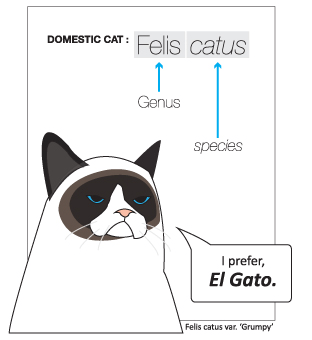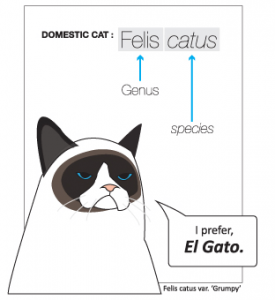
How many times a day do you write your name? Once, twice, three times, maybe not at all on some days. Well put a pen in your hand right now and write it down. Now lets analyze it!
 Your first and middle names are pretty specific to you. Those names give you an identity. Your last name also further solidifies that identity, but it is shared among those that you are directly related to in your family. This helps to keep a record from where you belong. Other living things have names too! They have a specific name much like our first name, and a more generic name that is shared among those that it shares a genetic relationship too. We call this name a scientific name.
Your first and middle names are pretty specific to you. Those names give you an identity. Your last name also further solidifies that identity, but it is shared among those that you are directly related to in your family. This helps to keep a record from where you belong. Other living things have names too! They have a specific name much like our first name, and a more generic name that is shared among those that it shares a genetic relationship too. We call this name a scientific name.
 A two-part scientific name, or more formally referred to as binomial nomenclature, is given to every organism that is identified and recognized by our global society. You know, those big, obnoxious-looking, italicized words that everyone has a hard time pronouncing? One for every living thing! Each one is granted with a generic name, or genus, based upon common biological and ancestral characteristics it shares with other organisms. A specific name, or species, is also established to give it individual, unique identification. Most living things are supplemented with a common name that’s more simplified and easy to remember, much like if someone were to be given a nickname. For example, Giant Kelp! That luscious, golden-brown alga that forests the waters around Catalina, California, and the Pacific, we commonly know it as Giant Kelp. More scientifically, we call it Macrocystis pyrifera.
A two-part scientific name, or more formally referred to as binomial nomenclature, is given to every organism that is identified and recognized by our global society. You know, those big, obnoxious-looking, italicized words that everyone has a hard time pronouncing? One for every living thing! Each one is granted with a generic name, or genus, based upon common biological and ancestral characteristics it shares with other organisms. A specific name, or species, is also established to give it individual, unique identification. Most living things are supplemented with a common name that’s more simplified and easy to remember, much like if someone were to be given a nickname. For example, Giant Kelp! That luscious, golden-brown alga that forests the waters around Catalina, California, and the Pacific, we commonly know it as Giant Kelp. More scientifically, we call it Macrocystis pyrifera.
 Scientific nomenclature originated as early as mid 300BC with Aristotle. The Greek philosopher established a simple system, classifying organisms as either plants or animals, with the animal group further divided based upon the presence of blood and manners of locomotion (e.g. wings, fins, fore- and hind limbs). As time went on, scientists started to develop a labeling method that aided in classifying new and already existing organisms. Nomenclature, at the time, included a name and physical descriptions highlighting external anatomy, color, and shape. All of the language used was mostly of Latin origin and sometimes Greek. This method was used up until the 1600s when Caspar Bauhin initiated a shift towards eliminating the inclusion of physical descriptors within an organism’s name and creating a more concise and simplified label using only two words. It was Carl Linnaeus, a Swedish botanist and physician, who later solidified and legitimized the entire system and the usage of binomial nomenclature among the science community with his 1753 publication of Species Plantarum.
Scientific nomenclature originated as early as mid 300BC with Aristotle. The Greek philosopher established a simple system, classifying organisms as either plants or animals, with the animal group further divided based upon the presence of blood and manners of locomotion (e.g. wings, fins, fore- and hind limbs). As time went on, scientists started to develop a labeling method that aided in classifying new and already existing organisms. Nomenclature, at the time, included a name and physical descriptions highlighting external anatomy, color, and shape. All of the language used was mostly of Latin origin and sometimes Greek. This method was used up until the 1600s when Caspar Bauhin initiated a shift towards eliminating the inclusion of physical descriptors within an organism’s name and creating a more concise and simplified label using only two words. It was Carl Linnaeus, a Swedish botanist and physician, who later solidified and legitimized the entire system and the usage of binomial nomenclature among the science community with his 1753 publication of Species Plantarum.
Linnaeus took the foundations of Aristotle’s work and created a more complex classification system of living things, dividing organisms into Kingdoms (initially plants and animals) with subsequent tiers of smaller, more specific groups based on similarities and differences ending at the genus and species levels. The adoption and use of this system carried on throughout time, providing much success in the consistent documentation of all living things, past and present. It has created unity among the global science community, bringing universality and continuity in naming, logging, and referencing organisms. It has even spawned two official codes of rule to guide the process of naming, the International Code of Zoological Nomenclature (ICZN) and the International Code of Nomenclature for algae, plants, and fungi (ICN), both of which mediate and preserve how newly discovered biota are identified and represented globally.
So once again fellow CIMI-ers, why don’t you Say My Name! OR, get to know your friendly, neighborhood critter friends by learning their scientific names. One of the best ways to a new friend’s heart is by knowing their name ;).
Written by John Cornett
Carl Linnaeus – http://study.com/cimages/multimages/16/taxonomy-binomial-nomenclature.jpg
El Gato – http://static1.squarespace.com/static/51c4c42ce4b03003ea9f3e75/53068e8ee4b03e3bf7ede484/53d0026be4b0768eeba45c75/1406147385306/?format=1000w
Taxonomic Classification – http://static.filmannex.com/users/galleries/298361/180px-Biological_classification_L_Pengo.svg_fa_rszd.jpg


